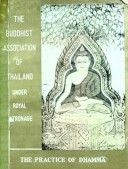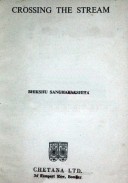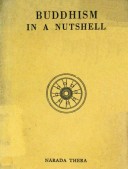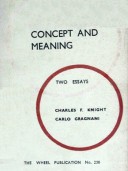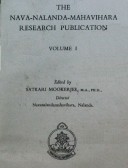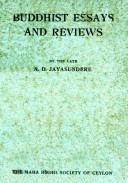Tìm Sách
Sách tiếng Anh-English >> The Buddhist Association of Thailand Under Royal Patronage
Thông tin tra cứu
- Tên sách : The Buddhist Association of Thailand Under Royal Patronage
- Tác giả : Sumedho Bhikshu
- Dịch giả :
- Ngôn ngữ : Anh
- Số trang : 98
- Nhà xuất bản : The Buddhist Association of Thailand
- Năm xuất bản : 1958
- Phân loại : Sách tiếng Anh-English
- MCB : 1210000003591
- OPAC :
- Tóm tắt :
PREFACE
Sabbadanam Dhammadanam Jinati
Sabbarasam Dhammaraso Jinati
Natthi Santi Paraman Sukham.
The gift of Dhamma exceeds all other gifts.
The flavour of Dhamrna exceeds all other flavours.
There is no happiness to compare with that which comes from a peaceful mind.
This Handbook for the Practice of Dhamma, is a brief exposition of those things which one needs to know in order to practise Dhamma in the right way. If one wishes to study the things which are discussed in it, in greater detail, one should turn to other books which deal more fully with these topics.
This book has been kept brief for those who have insufficient time to study more fully, for it is not necessary for one who is genuinely practising Dhamma to read many volumes. Those who are contented and satisfied with a little understanding of Dhamma need not read as far as those who strive for greater gains.
This book is divided into two parts. The first part deals with the Sensual Realm (Kãmãvacara-Bhũmi); the latter part (the remaining chapters) dealing with the Form Realm (Rũpĩivacara-Bhumi), the Formless Realm (Arupãvacara-Bhũmi) and the Transcendental Realm (Lokuttara-Bhũmi). This enables those who follow the Ruddha’s teachings to decide which of these realms he wishes to attain. If one is satisfied with the Sensual Realm, then one should look at the first part of the book and follow the practices which are described therein. If one prefers to attain the Form Realms, the Formless Realms or the Transcendental Realm, one should turn to the latter part of the book and practise the methods suggested in this part.
The author begs you to forgive any mistakes which may be found in this book.
CONTENTS
Basic Principles
PART I.
Chapter 1. DISTRIBUTION OF THE THREE REALMS OF EXISTENCE AND THE FOUR REALMS OF MIND
Chapter 2. THE SENSUAL REALM
The four Classes of Human Beings
Social Behaviour which accords with Dhamma
The Road to Ruin which one should avoid
The Virtues of being a Lay Devotee (Upàsìkã and Upãsaka) The Good Realm of Sense Desires (Kãmãvacara Kusala)
Objects of the Citta at the Time of Death
Samadhi in the Sensual Realm (Kũmãvacam)
Actions give rise to Results in accordance with the four Kammas
The Birth of Beings is like Trading
A Fourfold Teaching of Dhamma
The Sorrow of this World
Chapter 3. THE FORM REALM (Rupavacara Bhumi)
The five Hindrances are like diseases arising in the Heart
PART II.
Chapter 4. EXPLANATION OF THE FIRST STAGE (IN WHICH ONE SCRUTINIZES THE HEART BASE)
The Sense Doors and the States Free of Doors
Objects of the 84 Types of Citta
Chapter 5. EXPLANATION OF THE SECOND STAGE
Training the Citta in Samãdhi
Combating Mãra during Samãdhỉ practice
One who has conquered the Senses and is proficient in entering Jhana
The Identifying Mark of Second Jhana
Symbol (Nimitta) which arises in Samãdhi
Mara follows in accordance with one’s actions
Chapter 6. PROCESS OF APPERCEPTION IN THE APPAINMENT OF ABSORPTION (Appana-Javana-Vithi)
Chapter 7. ATTAINING THE FORMLESS REAIM
Elements of the Citta and the Bases on which the Citta depends
Summary of Stages One and Two
Chapter 8. EXPLANATION OF THE THIRD STAGE
The Citta attains freedom from the three Realms of Becoming
Chapter 9. EXPLANATION OF THE FOURTH STAGE
Root causes which give rise to the Formations (Sankhara)
Heart Base compared with a cinema screen
The method of withdrawing from Feeling
Chapter 10. EXPLANATION OF THE FIFTH STAGE
The method of letting go of the five Aggregates
Letting go of the four Graspings
Chapter 11. EXPLANATION OF THE SIXTH STAGE
The things which hide Wisdom
What hides the Three Characteristics (Ti-Lakkhana)?
Things on which one ought to reflect, and those on which one ought not to reflect
The Aggregates as Oneself, and the Aggregates correctly understood
Establishing the “Understanding of Arising and Falling
Explanation of the Four Noble Truths
Chapter 12. EXPLANATION OF THE SEVENTH STAGE-THOSE WHO DO NOT RELAPSE
Which Defilements are partly overcome and which are completely overcome in each of the Ariyan Paths
The Noble Disciple and the Ordinary Person have Faith in the Three-Jewels in different ways
PART III.
Chapter 13. SHORT APHORISMS
Chapter 14. CONCLUSION 1 SUMMING UP
 Facebook
Facebook
 Google
Google
 Google+
Google+
